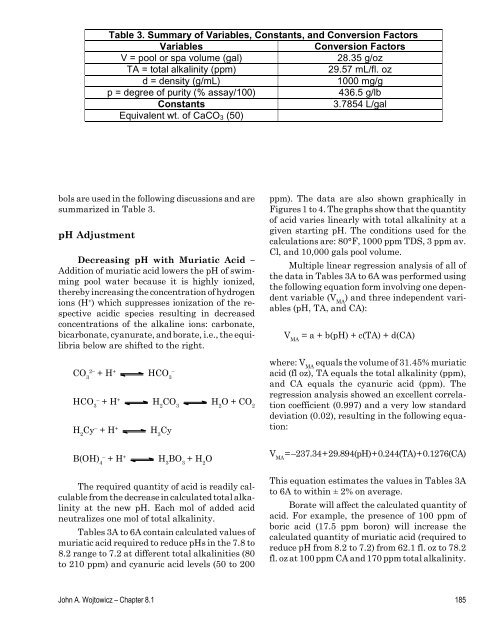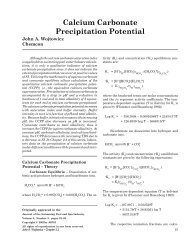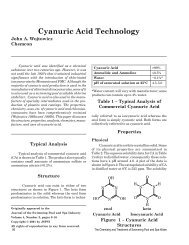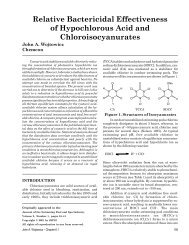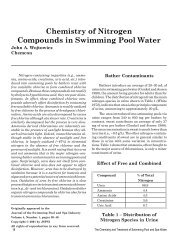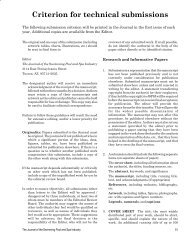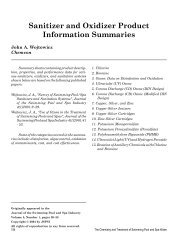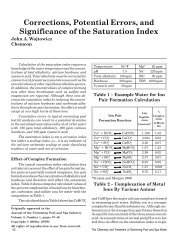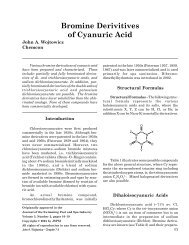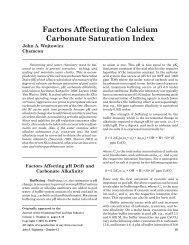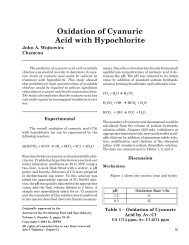Swimming Pool and Spa Water Chemical Adjustments - jspsi
Swimming Pool and Spa Water Chemical Adjustments - jspsi
Swimming Pool and Spa Water Chemical Adjustments - jspsi
Create successful ePaper yourself
Turn your PDF publications into a flip-book with our unique Google optimized e-Paper software.
ols are used in the following discussions <strong>and</strong> are<br />
summarized in Table 3.<br />
pH Adjustment<br />
Table 3. Summary of Variables, Constants, <strong>and</strong> Conversion Factors<br />
Variables Conversion Factors<br />
V = pool or spa volume (gal) 28.35 g/oz<br />
TA = total alkalinity (ppm) 29.57 mL/fl. oz<br />
d = density (g/mL) 1000 mg/g<br />
p = degree of purity (% assay/100) 436.5 g/lb<br />
Constants 3.7854 L/gal<br />
Equivalent wt. of CaCO3 (50)<br />
Decreasing pH with Muriatic Acid –<br />
Addition of muriatic acid lowers the pH of swimming<br />
pool water because it is highly ionized,<br />
thereby increasing the concentration of hydrogen<br />
ions (H + ) which suppresses ionization of the respective<br />
acidic species resulting in decreased<br />
concentrations of the alkaline ions: carbonate,<br />
bicarbonate, cyanurate, <strong>and</strong> borate, i.e., the equilibria<br />
below are shifted to the right.<br />
2– + –<br />
CO + H HCO 3<br />
3<br />
– + HCO + H H CO H O + CO 3<br />
2 3 2 2<br />
H 2 Cy – + H + H 3 Cy<br />
– + B(OH) + H H BO + H O<br />
4<br />
3 3 2<br />
The required quantity of acid is readily calculable<br />
from the decrease in calculated total alkalinity<br />
at the new pH. Each mol of added acid<br />
neutralizes one mol of total alkalinity.<br />
Tables 3A to 6A contain calculated values of<br />
muriatic acid required to reduce pHs in the 7.8 to<br />
8.2 range to 7.2 at different total alkalinities (80<br />
to 210 ppm) <strong>and</strong> cyanuric acid levels (50 to 200<br />
ppm). The data are also shown graphically in<br />
Figures 1 to 4. The graphs show that the quantity<br />
of acid varies linearly with total alkalinity at a<br />
given starting pH. The conditions used for the<br />
calculations are: 80°F, 1000 ppm TDS, 3 ppm av.<br />
Cl, <strong>and</strong> 10,000 gals pool volume.<br />
Multiple linear regression analysis of all of<br />
the data in Tables 3A to 6A was performed using<br />
the following equation form involving one dependent<br />
variable (V MA ) <strong>and</strong> three independent variables<br />
(pH, TA, <strong>and</strong> CA):<br />
V MA = a + b(pH) + c(TA) + d(CA)<br />
where: V MA equals the volume of 31.45% muriatic<br />
acid (fl oz), TA equals the total alkalinity (ppm),<br />
<strong>and</strong> CA equals the cyanuric acid (ppm). The<br />
regression analysis showed an excellent correlation<br />
coefficient (0.997) <strong>and</strong> a very low st<strong>and</strong>ard<br />
deviation (0.02), resulting in the following equation:<br />
V MA = – 237.34 + 29.894(pH) + 0.244(TA) + 0.1276(CA)<br />
This equation estimates the values in Tables 3A<br />
to 6A to within ± 2% on average.<br />
Borate will affect the calculated quantity of<br />
acid. For example, the presence of 100 ppm of<br />
boric acid (17.5 ppm boron) will increase the<br />
calculated quantity of muriatic acid (required to<br />
reduce pH from 8.2 to 7.2) from 62.1 fl. oz to 78.2<br />
fl. oz at 100 ppm CA <strong>and</strong> 170 ppm total alkalinity.<br />
John A. Wojtowicz – Chapter 8.1 185


